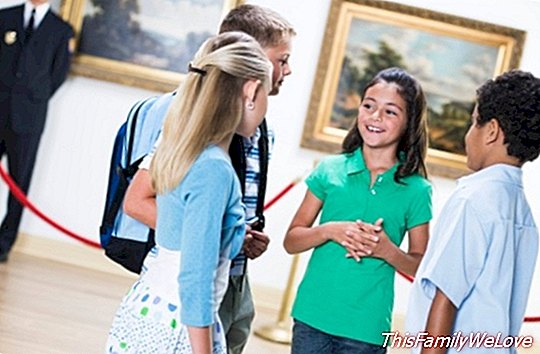Keys to bring culture and art to children

Knowing, understanding, valuing and appreciating the different manifestations of art is an invaluable source of enjoyment and personal enrichment. For this, parents can accustom their children from childhood to be in contact and enjoy the great works, thus enhancing the skills necessary for the development of good artistic taste.
Within the various aspects of the education of children, it is vital that they understand that human life in fullness is not reduced to the satisfaction of biological needs and desires. Parents must instill in them the need to link themselves to valuable realities, to high values (love, unity, goodness, justice, beauty ...) to develop one hundred percent as people. Therefore, the openness to values and specifically to beauty, is not a superfluous luxury in the educational process, but is fundamental for the personal formation of the child, from home and through their studies.
How do school subjects influence the approach to culture and art?
All the subjects that the children attend provide them access to culture and art tools, developing their perceptive skills and their sensitivity towards cultural manifestations.
- Spanish Language and Literature: literary heritage is accessed, reading, interpretation and evaluation of literary works and their relationship with other artistic productions such as music, painting or cinema are encouraged.
- Foreign language: learning languages allows them to get closer to the cultural heritage of other countries.
- Maths: by encouraging creativity and divergent thinking they allow, for example, to appreciate the beauty of musical structures.
- Knowledge of the Environment: they contribute to the knowledge and appreciation of cultural and artistic facts, the understanding of the social context in which they occurred, and make possible the critical analysis of a relevant selection of those facts.
- Physical education: the expressive resources of the body and movement are explored, and cultural manifestations such as sports, traditional games or dance are recognized and valued.
- Art Education and Music: contribute directly to this acquisition. Know the different codes and artistic techniques, learn to look, see, hear, observe, analyze, reflect and appreciate the aesthetic and cultural values of artistic productions.
- Extracurricular activities: trips, excursions, visits to museums or attending a concert * facilitate occasions for the development of this competition.
The atmosphere that one breathes at home
Likewise, the contribution of family education to the development and acquisition of cultural and artistic competence is not less. Possibly, your home is more full of cultural references than your child's school. It is at home where children can learn to make an active use of leisure and free time, in which cultural content plays a prominent role.
Your example is the main methodology for this learning. If you see dad and mom reading, listening to music, interested in cinema beyond pure entertainment, appreciating and enjoying different cultural manifestations, or venturing into literary or artistic creation and expression ..., you will be in a better position to transmit those habits and hobbies to children, that parents who opt for a leisure time based on passive distractions.
Art and culture: propose, never impose
In addition to the example, parents can encourage the development of this competition in children by proposing shared activities: reading or listening to music together, selecting television programs or movies to see and comment with family, visit monuments, museums, exhibitions; to do with them trips and trips, documenting them together previously and elaborating later a review of the trip, the photo album, etc.
But the key to developing common hobbies is in the enjoyment that produces both parties: if you do not recreate in the proposed activity, if you only participate in it by initiating the child, and if the child feels forced or participates only to please, the occasion will have been given, but it is very unlikely that it will become a habit. In this field impositions, unilateral programming or educational voluntarism do not work, because you would provoke long-lasting rejections when you wanted to create attachments.
Maria Lucea
Advisor: Mª Ángeles Almacellas
You may also like:
- How to teach children to appreciate art and beauty
- The great museums of Madrid with children
- The music and the development of children
- 8 keys to interpret children's drawings
- Music improves children's hearing




